BUSN20019 Strategic HRM: Driving Revenue Growth in Hospitality
VerifiedAdded on 2023/06/04
|24
|5024
|125
Report
AI Summary
This report investigates the impact of strategic human resource management (HRM) on revenue generation within the hospitality sector, using Hilton Hotel in Australia as a case study. It explores the relationship between effective HRM practices and revenue growth through a literature review, quantitative data analysis (regression and descriptive statistics) of secondary data from the Australian Bureau of Statistics and Hilton's website. The findings suggest a direct correlation between strategic HRM and revenue, emphasizing the importance of employee motivation and service delivery. The report concludes with recommendations for hospitality managers to implement effective HR strategies that enhance employee performance and drive revenue growth, while also acknowledging the limitations of the research.
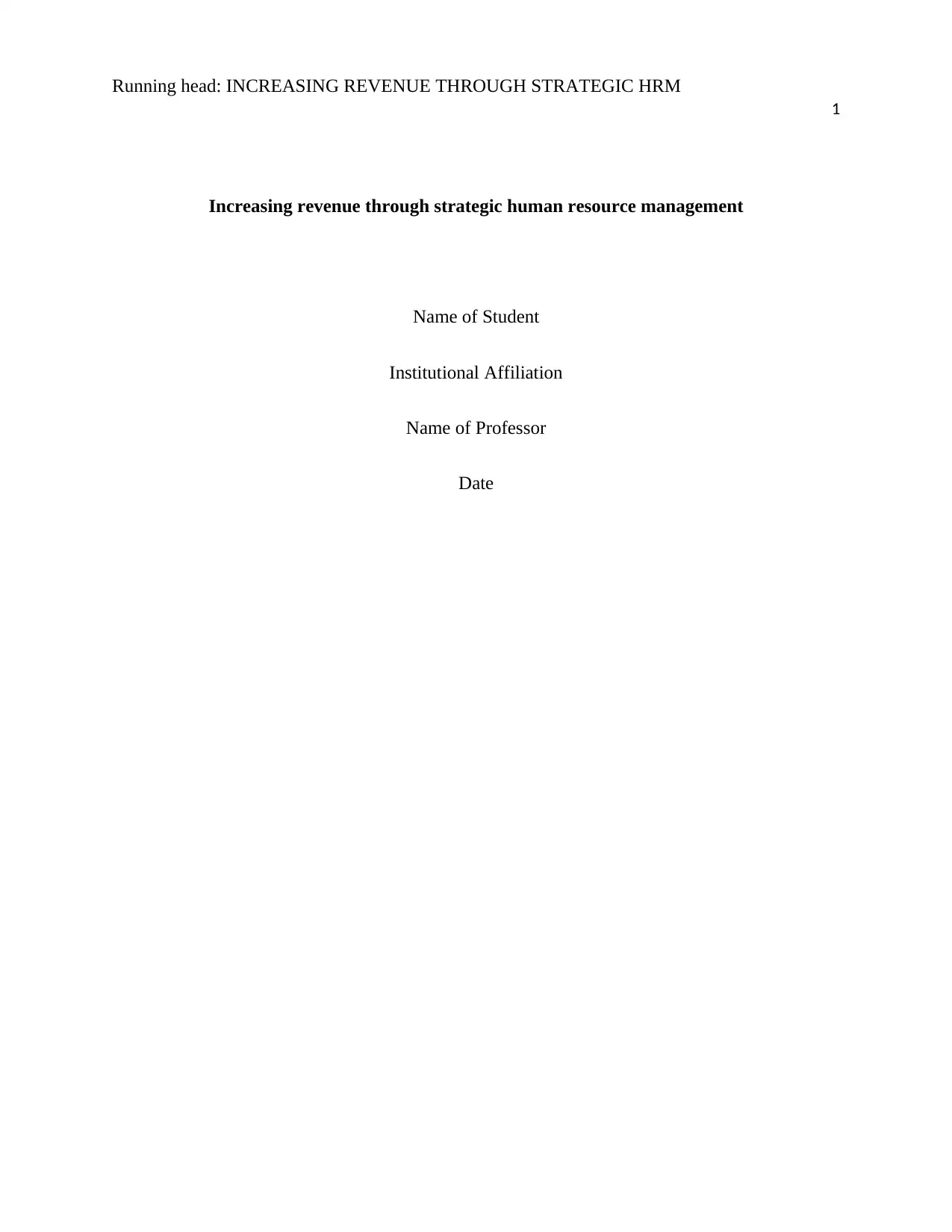
Running head: INCREASING REVENUE THROUGH STRATEGIC HRM
1
Increasing revenue through strategic human resource management
Name of Student
Institutional Affiliation
Name of Professor
Date
1
Increasing revenue through strategic human resource management
Name of Student
Institutional Affiliation
Name of Professor
Date
Paraphrase This Document
Need a fresh take? Get an instant paraphrase of this document with our AI Paraphraser
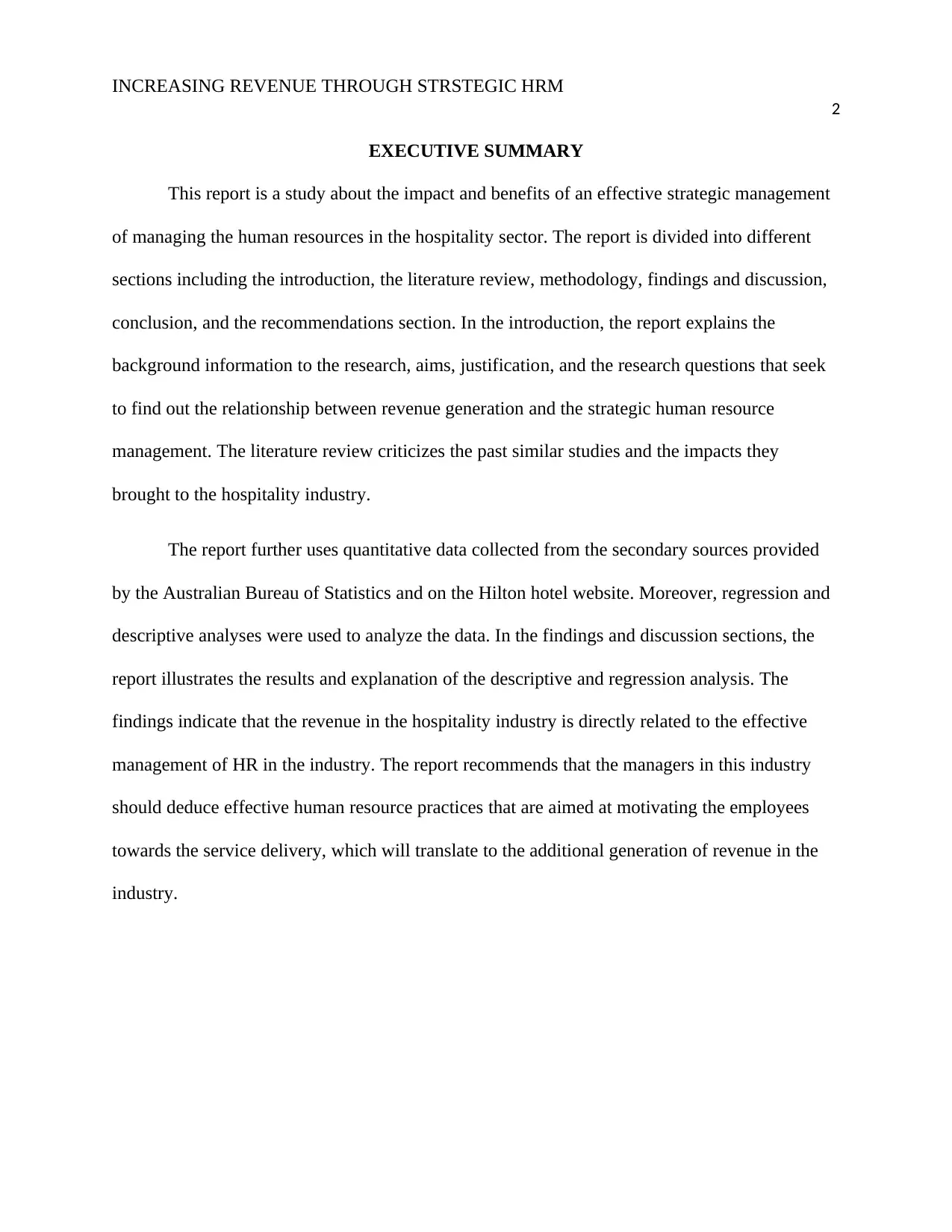
INCREASING REVENUE THROUGH STRSTEGIC HRM
2
EXECUTIVE SUMMARY
This report is a study about the impact and benefits of an effective strategic management
of managing the human resources in the hospitality sector. The report is divided into different
sections including the introduction, the literature review, methodology, findings and discussion,
conclusion, and the recommendations section. In the introduction, the report explains the
background information to the research, aims, justification, and the research questions that seek
to find out the relationship between revenue generation and the strategic human resource
management. The literature review criticizes the past similar studies and the impacts they
brought to the hospitality industry.
The report further uses quantitative data collected from the secondary sources provided
by the Australian Bureau of Statistics and on the Hilton hotel website. Moreover, regression and
descriptive analyses were used to analyze the data. In the findings and discussion sections, the
report illustrates the results and explanation of the descriptive and regression analysis. The
findings indicate that the revenue in the hospitality industry is directly related to the effective
management of HR in the industry. The report recommends that the managers in this industry
should deduce effective human resource practices that are aimed at motivating the employees
towards the service delivery, which will translate to the additional generation of revenue in the
industry.
2
EXECUTIVE SUMMARY
This report is a study about the impact and benefits of an effective strategic management
of managing the human resources in the hospitality sector. The report is divided into different
sections including the introduction, the literature review, methodology, findings and discussion,
conclusion, and the recommendations section. In the introduction, the report explains the
background information to the research, aims, justification, and the research questions that seek
to find out the relationship between revenue generation and the strategic human resource
management. The literature review criticizes the past similar studies and the impacts they
brought to the hospitality industry.
The report further uses quantitative data collected from the secondary sources provided
by the Australian Bureau of Statistics and on the Hilton hotel website. Moreover, regression and
descriptive analyses were used to analyze the data. In the findings and discussion sections, the
report illustrates the results and explanation of the descriptive and regression analysis. The
findings indicate that the revenue in the hospitality industry is directly related to the effective
management of HR in the industry. The report recommends that the managers in this industry
should deduce effective human resource practices that are aimed at motivating the employees
towards the service delivery, which will translate to the additional generation of revenue in the
industry.
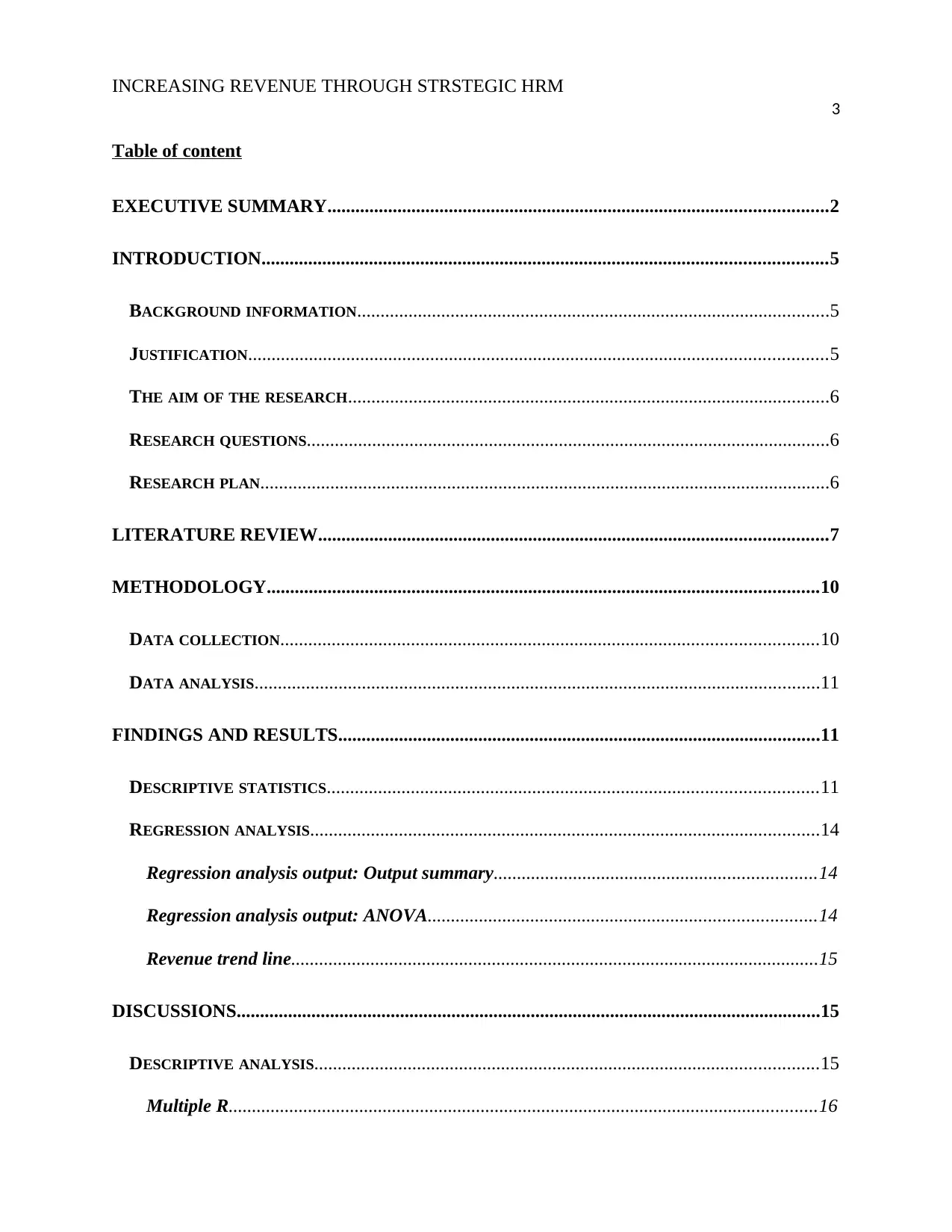
INCREASING REVENUE THROUGH STRSTEGIC HRM
3
Table of content
EXECUTIVE SUMMARY...........................................................................................................2
INTRODUCTION.........................................................................................................................5
BACKGROUND INFORMATION.....................................................................................................5
JUSTIFICATION............................................................................................................................5
THE AIM OF THE RESEARCH.......................................................................................................6
RESEARCH QUESTIONS................................................................................................................6
RESEARCH PLAN..........................................................................................................................6
LITERATURE REVIEW.............................................................................................................7
METHODOLOGY......................................................................................................................10
DATA COLLECTION...................................................................................................................10
DATA ANALYSIS.........................................................................................................................11
FINDINGS AND RESULTS.......................................................................................................11
DESCRIPTIVE STATISTICS.........................................................................................................11
REGRESSION ANALYSIS.............................................................................................................14
Regression analysis output: Output summary.....................................................................14
Regression analysis output: ANOVA...................................................................................14
Revenue trend line.................................................................................................................15
DISCUSSIONS.............................................................................................................................15
DESCRIPTIVE ANALYSIS............................................................................................................15
Multiple R..............................................................................................................................16
3
Table of content
EXECUTIVE SUMMARY...........................................................................................................2
INTRODUCTION.........................................................................................................................5
BACKGROUND INFORMATION.....................................................................................................5
JUSTIFICATION............................................................................................................................5
THE AIM OF THE RESEARCH.......................................................................................................6
RESEARCH QUESTIONS................................................................................................................6
RESEARCH PLAN..........................................................................................................................6
LITERATURE REVIEW.............................................................................................................7
METHODOLOGY......................................................................................................................10
DATA COLLECTION...................................................................................................................10
DATA ANALYSIS.........................................................................................................................11
FINDINGS AND RESULTS.......................................................................................................11
DESCRIPTIVE STATISTICS.........................................................................................................11
REGRESSION ANALYSIS.............................................................................................................14
Regression analysis output: Output summary.....................................................................14
Regression analysis output: ANOVA...................................................................................14
Revenue trend line.................................................................................................................15
DISCUSSIONS.............................................................................................................................15
DESCRIPTIVE ANALYSIS............................................................................................................15
Multiple R..............................................................................................................................16
⊘ This is a preview!⊘
Do you want full access?
Subscribe today to unlock all pages.

Trusted by 1+ million students worldwide
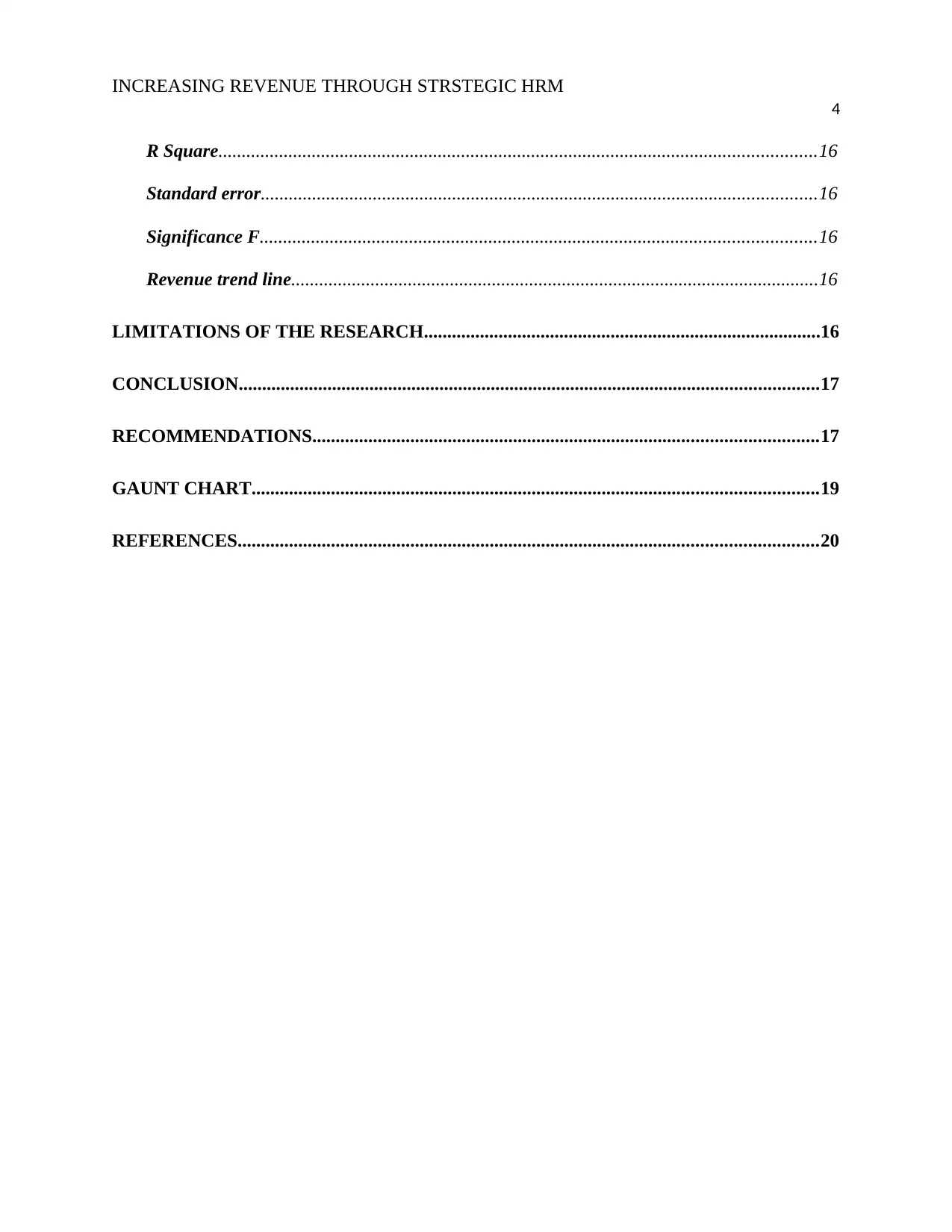
INCREASING REVENUE THROUGH STRSTEGIC HRM
4
R Square................................................................................................................................16
Standard error.......................................................................................................................16
Significance F.......................................................................................................................16
Revenue trend line.................................................................................................................16
LIMITATIONS OF THE RESEARCH.....................................................................................16
CONCLUSION............................................................................................................................17
RECOMMENDATIONS............................................................................................................17
GAUNT CHART.........................................................................................................................19
REFERENCES............................................................................................................................20
4
R Square................................................................................................................................16
Standard error.......................................................................................................................16
Significance F.......................................................................................................................16
Revenue trend line.................................................................................................................16
LIMITATIONS OF THE RESEARCH.....................................................................................16
CONCLUSION............................................................................................................................17
RECOMMENDATIONS............................................................................................................17
GAUNT CHART.........................................................................................................................19
REFERENCES............................................................................................................................20
Paraphrase This Document
Need a fresh take? Get an instant paraphrase of this document with our AI Paraphraser
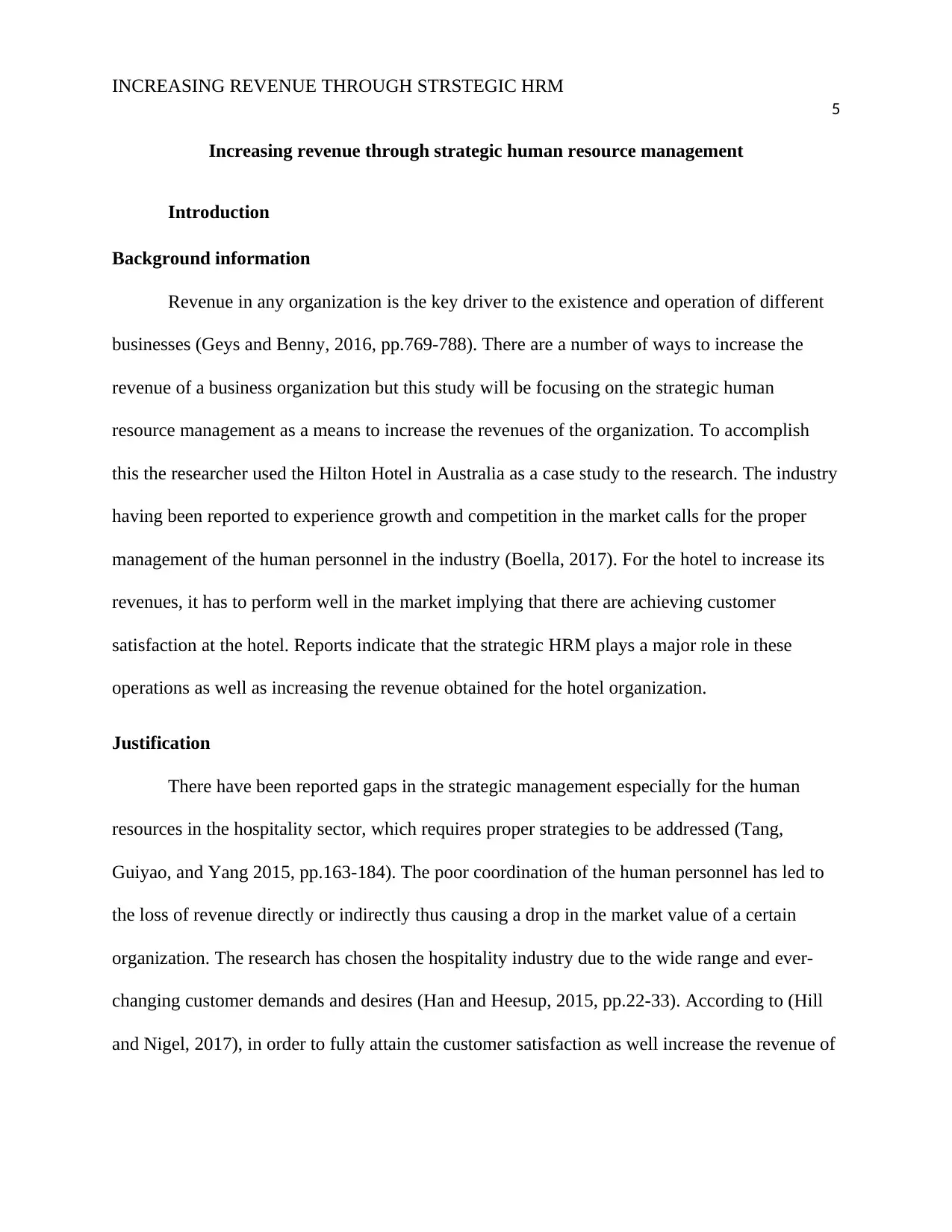
INCREASING REVENUE THROUGH STRSTEGIC HRM
5
Increasing revenue through strategic human resource management
Introduction
Background information
Revenue in any organization is the key driver to the existence and operation of different
businesses (Geys and Benny, 2016, pp.769-788). There are a number of ways to increase the
revenue of a business organization but this study will be focusing on the strategic human
resource management as a means to increase the revenues of the organization. To accomplish
this the researcher used the Hilton Hotel in Australia as a case study to the research. The industry
having been reported to experience growth and competition in the market calls for the proper
management of the human personnel in the industry (Boella, 2017). For the hotel to increase its
revenues, it has to perform well in the market implying that there are achieving customer
satisfaction at the hotel. Reports indicate that the strategic HRM plays a major role in these
operations as well as increasing the revenue obtained for the hotel organization.
Justification
There have been reported gaps in the strategic management especially for the human
resources in the hospitality sector, which requires proper strategies to be addressed (Tang,
Guiyao, and Yang 2015, pp.163-184). The poor coordination of the human personnel has led to
the loss of revenue directly or indirectly thus causing a drop in the market value of a certain
organization. The research has chosen the hospitality industry due to the wide range and ever-
changing customer demands and desires (Han and Heesup, 2015, pp.22-33). According to (Hill
and Nigel, 2017), in order to fully attain the customer satisfaction as well increase the revenue of
5
Increasing revenue through strategic human resource management
Introduction
Background information
Revenue in any organization is the key driver to the existence and operation of different
businesses (Geys and Benny, 2016, pp.769-788). There are a number of ways to increase the
revenue of a business organization but this study will be focusing on the strategic human
resource management as a means to increase the revenues of the organization. To accomplish
this the researcher used the Hilton Hotel in Australia as a case study to the research. The industry
having been reported to experience growth and competition in the market calls for the proper
management of the human personnel in the industry (Boella, 2017). For the hotel to increase its
revenues, it has to perform well in the market implying that there are achieving customer
satisfaction at the hotel. Reports indicate that the strategic HRM plays a major role in these
operations as well as increasing the revenue obtained for the hotel organization.
Justification
There have been reported gaps in the strategic management especially for the human
resources in the hospitality sector, which requires proper strategies to be addressed (Tang,
Guiyao, and Yang 2015, pp.163-184). The poor coordination of the human personnel has led to
the loss of revenue directly or indirectly thus causing a drop in the market value of a certain
organization. The research has chosen the hospitality industry due to the wide range and ever-
changing customer demands and desires (Han and Heesup, 2015, pp.22-33). According to (Hill
and Nigel, 2017), in order to fully attain the customer satisfaction as well increase the revenue of
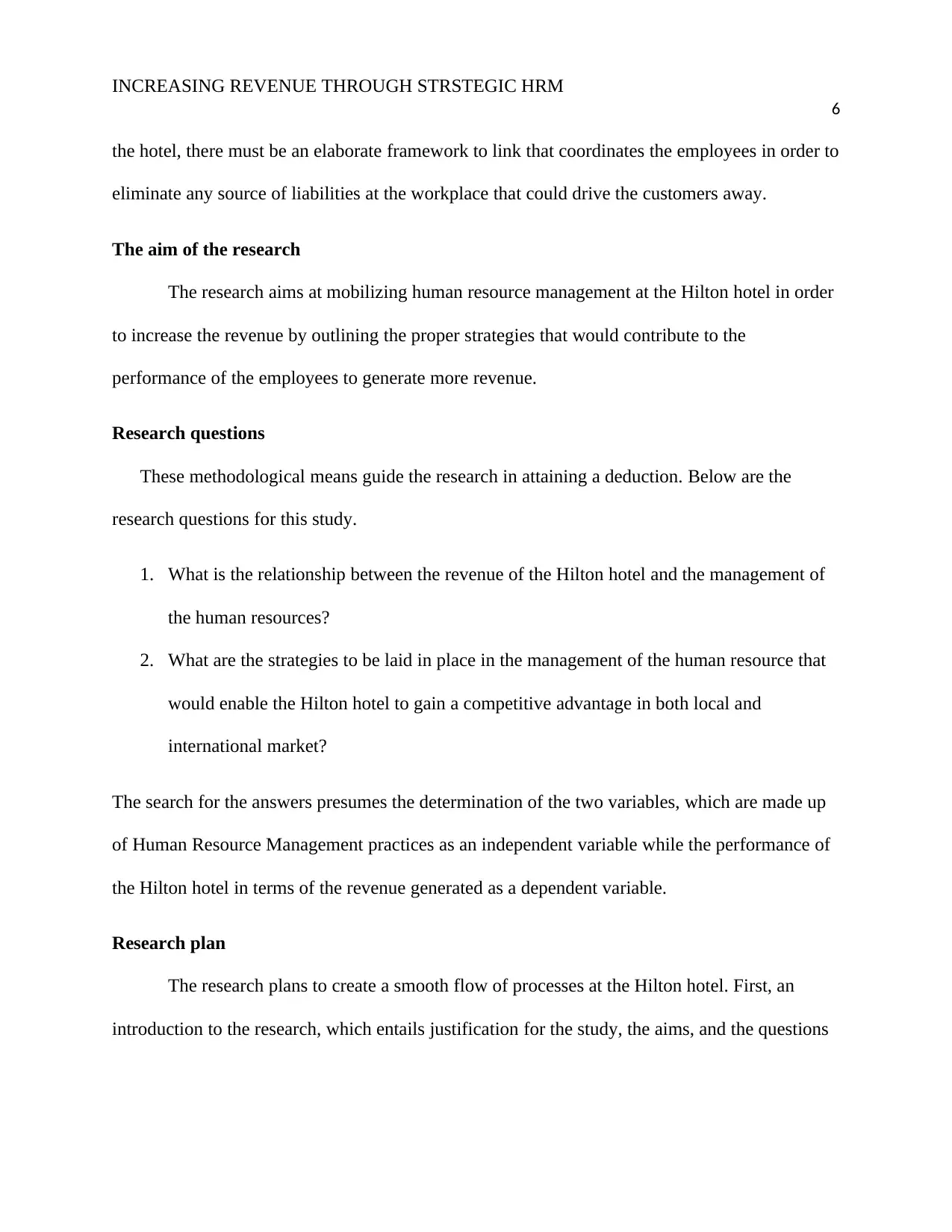
INCREASING REVENUE THROUGH STRSTEGIC HRM
6
the hotel, there must be an elaborate framework to link that coordinates the employees in order to
eliminate any source of liabilities at the workplace that could drive the customers away.
The aim of the research
The research aims at mobilizing human resource management at the Hilton hotel in order
to increase the revenue by outlining the proper strategies that would contribute to the
performance of the employees to generate more revenue.
Research questions
These methodological means guide the research in attaining a deduction. Below are the
research questions for this study.
1. What is the relationship between the revenue of the Hilton hotel and the management of
the human resources?
2. What are the strategies to be laid in place in the management of the human resource that
would enable the Hilton hotel to gain a competitive advantage in both local and
international market?
The search for the answers presumes the determination of the two variables, which are made up
of Human Resource Management practices as an independent variable while the performance of
the Hilton hotel in terms of the revenue generated as a dependent variable.
Research plan
The research plans to create a smooth flow of processes at the Hilton hotel. First, an
introduction to the research, which entails justification for the study, the aims, and the questions
6
the hotel, there must be an elaborate framework to link that coordinates the employees in order to
eliminate any source of liabilities at the workplace that could drive the customers away.
The aim of the research
The research aims at mobilizing human resource management at the Hilton hotel in order
to increase the revenue by outlining the proper strategies that would contribute to the
performance of the employees to generate more revenue.
Research questions
These methodological means guide the research in attaining a deduction. Below are the
research questions for this study.
1. What is the relationship between the revenue of the Hilton hotel and the management of
the human resources?
2. What are the strategies to be laid in place in the management of the human resource that
would enable the Hilton hotel to gain a competitive advantage in both local and
international market?
The search for the answers presumes the determination of the two variables, which are made up
of Human Resource Management practices as an independent variable while the performance of
the Hilton hotel in terms of the revenue generated as a dependent variable.
Research plan
The research plans to create a smooth flow of processes at the Hilton hotel. First, an
introduction to the research, which entails justification for the study, the aims, and the questions
⊘ This is a preview!⊘
Do you want full access?
Subscribe today to unlock all pages.

Trusted by 1+ million students worldwide
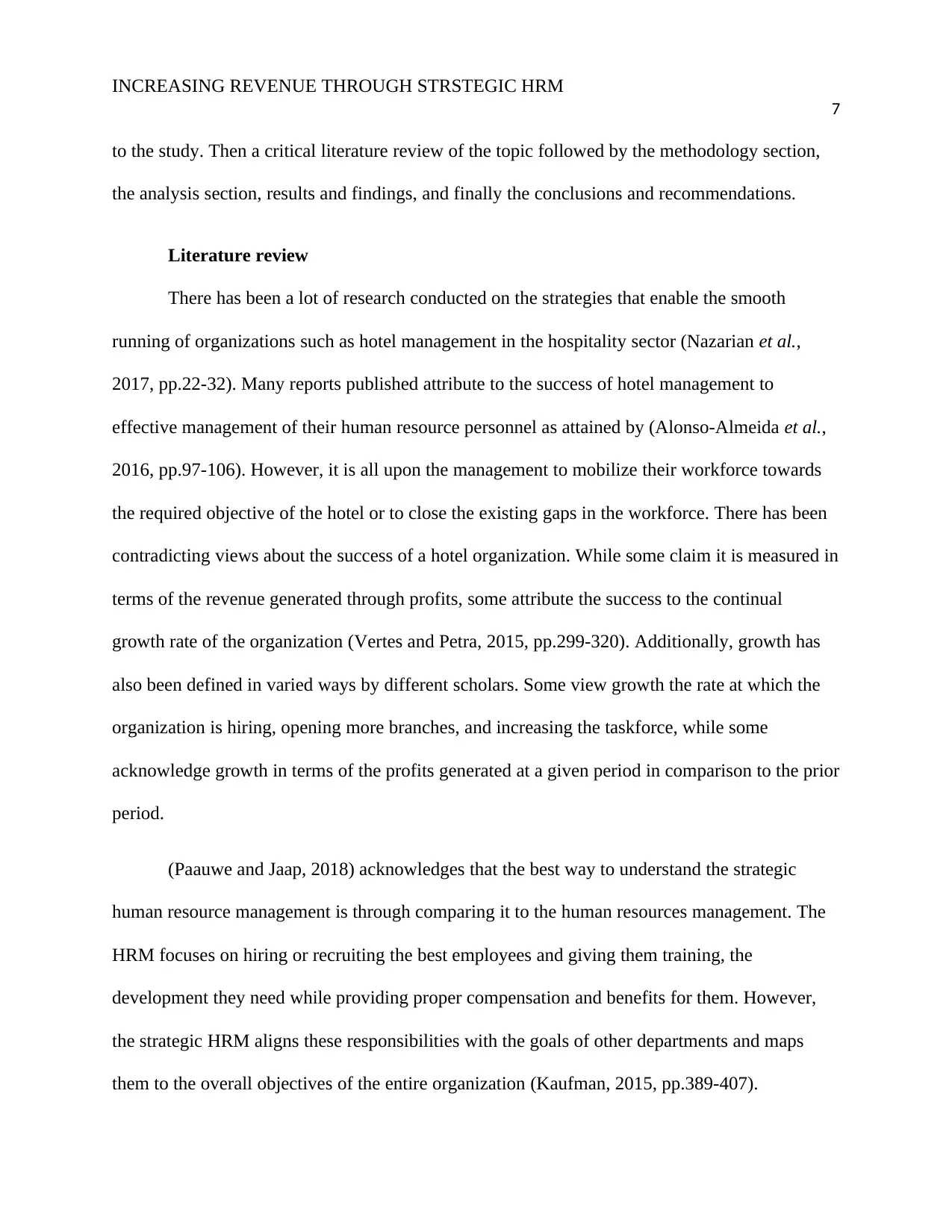
INCREASING REVENUE THROUGH STRSTEGIC HRM
7
to the study. Then a critical literature review of the topic followed by the methodology section,
the analysis section, results and findings, and finally the conclusions and recommendations.
Literature review
There has been a lot of research conducted on the strategies that enable the smooth
running of organizations such as hotel management in the hospitality sector (Nazarian et al.,
2017, pp.22-32). Many reports published attribute to the success of hotel management to
effective management of their human resource personnel as attained by (Alonso-Almeida et al.,
2016, pp.97-106). However, it is all upon the management to mobilize their workforce towards
the required objective of the hotel or to close the existing gaps in the workforce. There has been
contradicting views about the success of a hotel organization. While some claim it is measured in
terms of the revenue generated through profits, some attribute the success to the continual
growth rate of the organization (Vertes and Petra, 2015, pp.299-320). Additionally, growth has
also been defined in varied ways by different scholars. Some view growth the rate at which the
organization is hiring, opening more branches, and increasing the taskforce, while some
acknowledge growth in terms of the profits generated at a given period in comparison to the prior
period.
(Paauwe and Jaap, 2018) acknowledges that the best way to understand the strategic
human resource management is through comparing it to the human resources management. The
HRM focuses on hiring or recruiting the best employees and giving them training, the
development they need while providing proper compensation and benefits for them. However,
the strategic HRM aligns these responsibilities with the goals of other departments and maps
them to the overall objectives of the entire organization (Kaufman, 2015, pp.389-407).
7
to the study. Then a critical literature review of the topic followed by the methodology section,
the analysis section, results and findings, and finally the conclusions and recommendations.
Literature review
There has been a lot of research conducted on the strategies that enable the smooth
running of organizations such as hotel management in the hospitality sector (Nazarian et al.,
2017, pp.22-32). Many reports published attribute to the success of hotel management to
effective management of their human resource personnel as attained by (Alonso-Almeida et al.,
2016, pp.97-106). However, it is all upon the management to mobilize their workforce towards
the required objective of the hotel or to close the existing gaps in the workforce. There has been
contradicting views about the success of a hotel organization. While some claim it is measured in
terms of the revenue generated through profits, some attribute the success to the continual
growth rate of the organization (Vertes and Petra, 2015, pp.299-320). Additionally, growth has
also been defined in varied ways by different scholars. Some view growth the rate at which the
organization is hiring, opening more branches, and increasing the taskforce, while some
acknowledge growth in terms of the profits generated at a given period in comparison to the prior
period.
(Paauwe and Jaap, 2018) acknowledges that the best way to understand the strategic
human resource management is through comparing it to the human resources management. The
HRM focuses on hiring or recruiting the best employees and giving them training, the
development they need while providing proper compensation and benefits for them. However,
the strategic HRM aligns these responsibilities with the goals of other departments and maps
them to the overall objectives of the entire organization (Kaufman, 2015, pp.389-407).
Paraphrase This Document
Need a fresh take? Get an instant paraphrase of this document with our AI Paraphraser
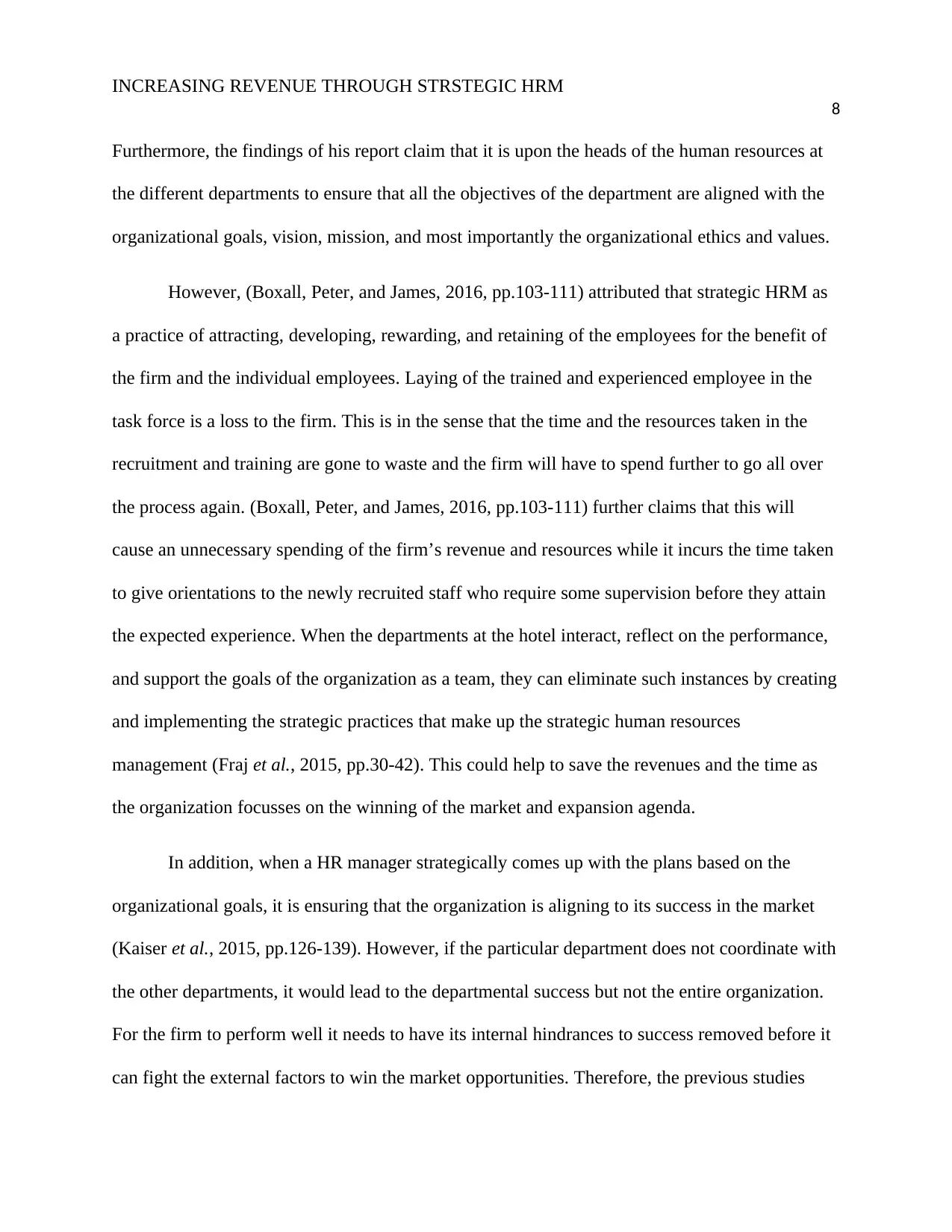
INCREASING REVENUE THROUGH STRSTEGIC HRM
8
Furthermore, the findings of his report claim that it is upon the heads of the human resources at
the different departments to ensure that all the objectives of the department are aligned with the
organizational goals, vision, mission, and most importantly the organizational ethics and values.
However, (Boxall, Peter, and James, 2016, pp.103-111) attributed that strategic HRM as
a practice of attracting, developing, rewarding, and retaining of the employees for the benefit of
the firm and the individual employees. Laying of the trained and experienced employee in the
task force is a loss to the firm. This is in the sense that the time and the resources taken in the
recruitment and training are gone to waste and the firm will have to spend further to go all over
the process again. (Boxall, Peter, and James, 2016, pp.103-111) further claims that this will
cause an unnecessary spending of the firm’s revenue and resources while it incurs the time taken
to give orientations to the newly recruited staff who require some supervision before they attain
the expected experience. When the departments at the hotel interact, reflect on the performance,
and support the goals of the organization as a team, they can eliminate such instances by creating
and implementing the strategic practices that make up the strategic human resources
management (Fraj et al., 2015, pp.30-42). This could help to save the revenues and the time as
the organization focusses on the winning of the market and expansion agenda.
In addition, when a HR manager strategically comes up with the plans based on the
organizational goals, it is ensuring that the organization is aligning to its success in the market
(Kaiser et al., 2015, pp.126-139). However, if the particular department does not coordinate with
the other departments, it would lead to the departmental success but not the entire organization.
For the firm to perform well it needs to have its internal hindrances to success removed before it
can fight the external factors to win the market opportunities. Therefore, the previous studies
8
Furthermore, the findings of his report claim that it is upon the heads of the human resources at
the different departments to ensure that all the objectives of the department are aligned with the
organizational goals, vision, mission, and most importantly the organizational ethics and values.
However, (Boxall, Peter, and James, 2016, pp.103-111) attributed that strategic HRM as
a practice of attracting, developing, rewarding, and retaining of the employees for the benefit of
the firm and the individual employees. Laying of the trained and experienced employee in the
task force is a loss to the firm. This is in the sense that the time and the resources taken in the
recruitment and training are gone to waste and the firm will have to spend further to go all over
the process again. (Boxall, Peter, and James, 2016, pp.103-111) further claims that this will
cause an unnecessary spending of the firm’s revenue and resources while it incurs the time taken
to give orientations to the newly recruited staff who require some supervision before they attain
the expected experience. When the departments at the hotel interact, reflect on the performance,
and support the goals of the organization as a team, they can eliminate such instances by creating
and implementing the strategic practices that make up the strategic human resources
management (Fraj et al., 2015, pp.30-42). This could help to save the revenues and the time as
the organization focusses on the winning of the market and expansion agenda.
In addition, when a HR manager strategically comes up with the plans based on the
organizational goals, it is ensuring that the organization is aligning to its success in the market
(Kaiser et al., 2015, pp.126-139). However, if the particular department does not coordinate with
the other departments, it would lead to the departmental success but not the entire organization.
For the firm to perform well it needs to have its internal hindrances to success removed before it
can fight the external factors to win the market opportunities. Therefore, the previous studies
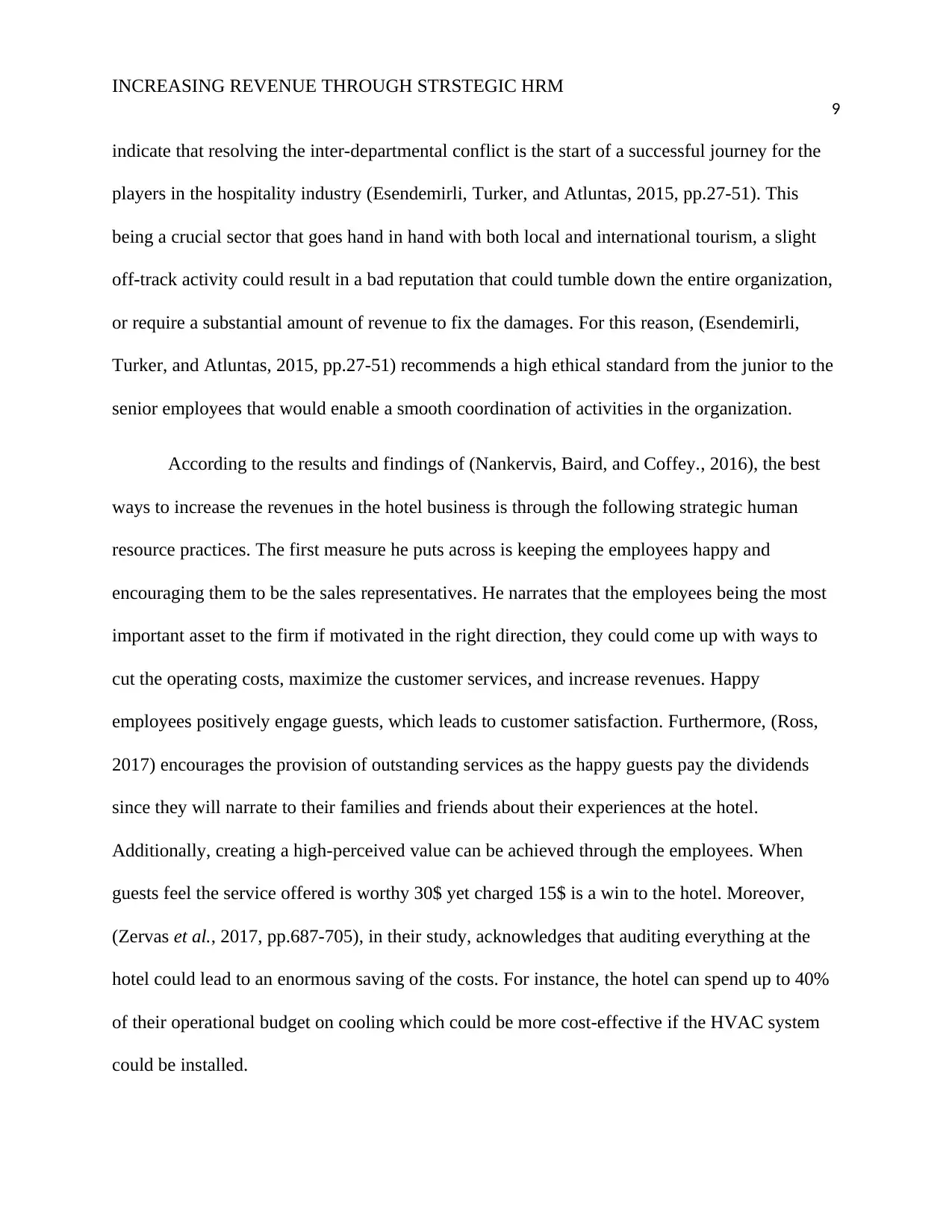
INCREASING REVENUE THROUGH STRSTEGIC HRM
9
indicate that resolving the inter-departmental conflict is the start of a successful journey for the
players in the hospitality industry (Esendemirli, Turker, and Atluntas, 2015, pp.27-51). This
being a crucial sector that goes hand in hand with both local and international tourism, a slight
off-track activity could result in a bad reputation that could tumble down the entire organization,
or require a substantial amount of revenue to fix the damages. For this reason, (Esendemirli,
Turker, and Atluntas, 2015, pp.27-51) recommends a high ethical standard from the junior to the
senior employees that would enable a smooth coordination of activities in the organization.
According to the results and findings of (Nankervis, Baird, and Coffey., 2016), the best
ways to increase the revenues in the hotel business is through the following strategic human
resource practices. The first measure he puts across is keeping the employees happy and
encouraging them to be the sales representatives. He narrates that the employees being the most
important asset to the firm if motivated in the right direction, they could come up with ways to
cut the operating costs, maximize the customer services, and increase revenues. Happy
employees positively engage guests, which leads to customer satisfaction. Furthermore, (Ross,
2017) encourages the provision of outstanding services as the happy guests pay the dividends
since they will narrate to their families and friends about their experiences at the hotel.
Additionally, creating a high-perceived value can be achieved through the employees. When
guests feel the service offered is worthy 30$ yet charged 15$ is a win to the hotel. Moreover,
(Zervas et al., 2017, pp.687-705), in their study, acknowledges that auditing everything at the
hotel could lead to an enormous saving of the costs. For instance, the hotel can spend up to 40%
of their operational budget on cooling which could be more cost-effective if the HVAC system
could be installed.
9
indicate that resolving the inter-departmental conflict is the start of a successful journey for the
players in the hospitality industry (Esendemirli, Turker, and Atluntas, 2015, pp.27-51). This
being a crucial sector that goes hand in hand with both local and international tourism, a slight
off-track activity could result in a bad reputation that could tumble down the entire organization,
or require a substantial amount of revenue to fix the damages. For this reason, (Esendemirli,
Turker, and Atluntas, 2015, pp.27-51) recommends a high ethical standard from the junior to the
senior employees that would enable a smooth coordination of activities in the organization.
According to the results and findings of (Nankervis, Baird, and Coffey., 2016), the best
ways to increase the revenues in the hotel business is through the following strategic human
resource practices. The first measure he puts across is keeping the employees happy and
encouraging them to be the sales representatives. He narrates that the employees being the most
important asset to the firm if motivated in the right direction, they could come up with ways to
cut the operating costs, maximize the customer services, and increase revenues. Happy
employees positively engage guests, which leads to customer satisfaction. Furthermore, (Ross,
2017) encourages the provision of outstanding services as the happy guests pay the dividends
since they will narrate to their families and friends about their experiences at the hotel.
Additionally, creating a high-perceived value can be achieved through the employees. When
guests feel the service offered is worthy 30$ yet charged 15$ is a win to the hotel. Moreover,
(Zervas et al., 2017, pp.687-705), in their study, acknowledges that auditing everything at the
hotel could lead to an enormous saving of the costs. For instance, the hotel can spend up to 40%
of their operational budget on cooling which could be more cost-effective if the HVAC system
could be installed.
⊘ This is a preview!⊘
Do you want full access?
Subscribe today to unlock all pages.

Trusted by 1+ million students worldwide
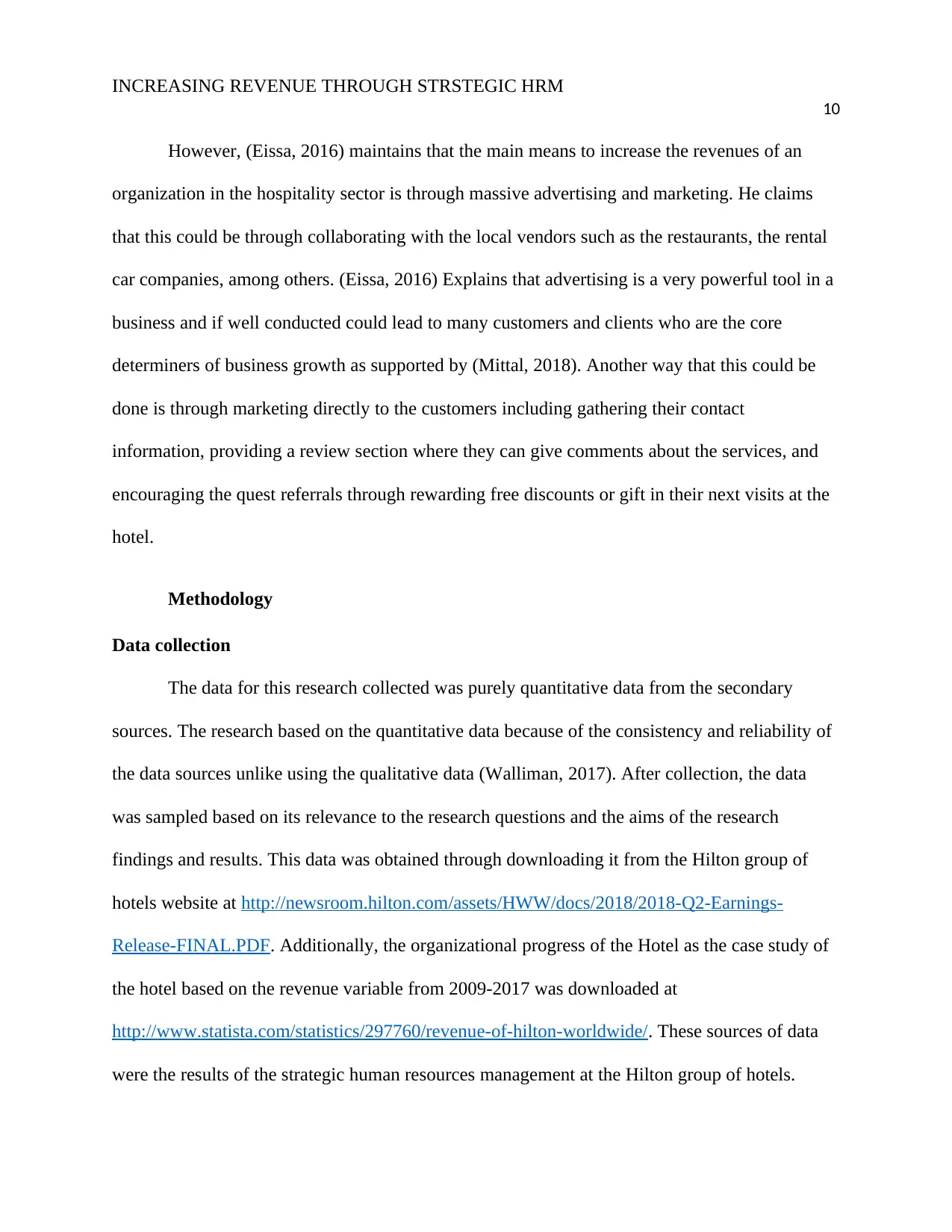
INCREASING REVENUE THROUGH STRSTEGIC HRM
10
However, (Eissa, 2016) maintains that the main means to increase the revenues of an
organization in the hospitality sector is through massive advertising and marketing. He claims
that this could be through collaborating with the local vendors such as the restaurants, the rental
car companies, among others. (Eissa, 2016) Explains that advertising is a very powerful tool in a
business and if well conducted could lead to many customers and clients who are the core
determiners of business growth as supported by (Mittal, 2018). Another way that this could be
done is through marketing directly to the customers including gathering their contact
information, providing a review section where they can give comments about the services, and
encouraging the quest referrals through rewarding free discounts or gift in their next visits at the
hotel.
Methodology
Data collection
The data for this research collected was purely quantitative data from the secondary
sources. The research based on the quantitative data because of the consistency and reliability of
the data sources unlike using the qualitative data (Walliman, 2017). After collection, the data
was sampled based on its relevance to the research questions and the aims of the research
findings and results. This data was obtained through downloading it from the Hilton group of
hotels website at http://newsroom.hilton.com/assets/HWW/docs/2018/2018-Q2-Earnings-
Release-FINAL.PDF. Additionally, the organizational progress of the Hotel as the case study of
the hotel based on the revenue variable from 2009-2017 was downloaded at
http://www.statista.com/statistics/297760/revenue-of-hilton-worldwide/. These sources of data
were the results of the strategic human resources management at the Hilton group of hotels.
10
However, (Eissa, 2016) maintains that the main means to increase the revenues of an
organization in the hospitality sector is through massive advertising and marketing. He claims
that this could be through collaborating with the local vendors such as the restaurants, the rental
car companies, among others. (Eissa, 2016) Explains that advertising is a very powerful tool in a
business and if well conducted could lead to many customers and clients who are the core
determiners of business growth as supported by (Mittal, 2018). Another way that this could be
done is through marketing directly to the customers including gathering their contact
information, providing a review section where they can give comments about the services, and
encouraging the quest referrals through rewarding free discounts or gift in their next visits at the
hotel.
Methodology
Data collection
The data for this research collected was purely quantitative data from the secondary
sources. The research based on the quantitative data because of the consistency and reliability of
the data sources unlike using the qualitative data (Walliman, 2017). After collection, the data
was sampled based on its relevance to the research questions and the aims of the research
findings and results. This data was obtained through downloading it from the Hilton group of
hotels website at http://newsroom.hilton.com/assets/HWW/docs/2018/2018-Q2-Earnings-
Release-FINAL.PDF. Additionally, the organizational progress of the Hotel as the case study of
the hotel based on the revenue variable from 2009-2017 was downloaded at
http://www.statista.com/statistics/297760/revenue-of-hilton-worldwide/. These sources of data
were the results of the strategic human resources management at the Hilton group of hotels.
Paraphrase This Document
Need a fresh take? Get an instant paraphrase of this document with our AI Paraphraser
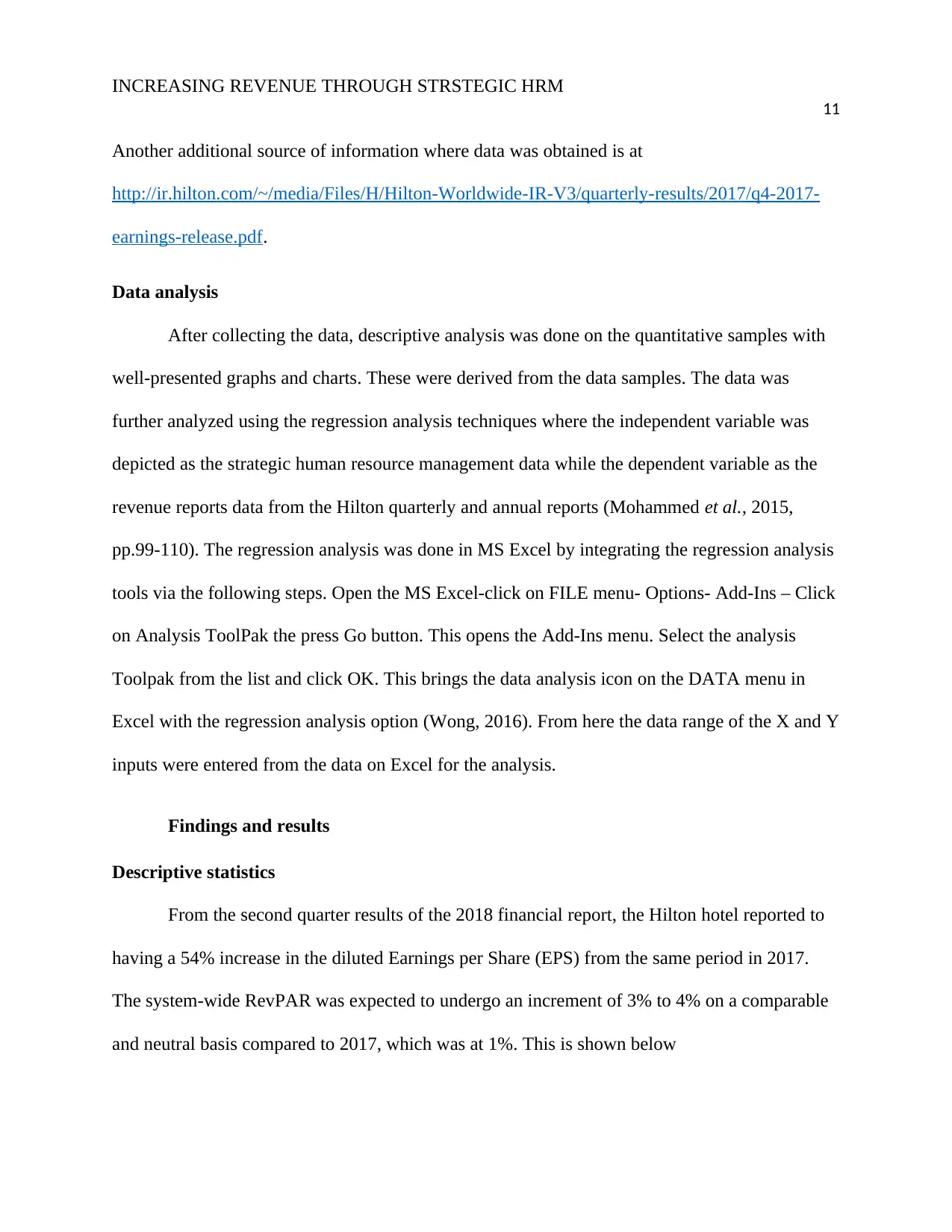
INCREASING REVENUE THROUGH STRSTEGIC HRM
11
Another additional source of information where data was obtained is at
http://ir.hilton.com/~/media/Files/H/Hilton-Worldwide-IR-V3/quarterly-results/2017/q4-2017-
earnings-release.pdf.
Data analysis
After collecting the data, descriptive analysis was done on the quantitative samples with
well-presented graphs and charts. These were derived from the data samples. The data was
further analyzed using the regression analysis techniques where the independent variable was
depicted as the strategic human resource management data while the dependent variable as the
revenue reports data from the Hilton quarterly and annual reports (Mohammed et al., 2015,
pp.99-110). The regression analysis was done in MS Excel by integrating the regression analysis
tools via the following steps. Open the MS Excel-click on FILE menu- Options- Add-Ins – Click
on Analysis ToolPak the press Go button. This opens the Add-Ins menu. Select the analysis
Toolpak from the list and click OK. This brings the data analysis icon on the DATA menu in
Excel with the regression analysis option (Wong, 2016). From here the data range of the X and Y
inputs were entered from the data on Excel for the analysis.
Findings and results
Descriptive statistics
From the second quarter results of the 2018 financial report, the Hilton hotel reported to
having a 54% increase in the diluted Earnings per Share (EPS) from the same period in 2017.
The system-wide RevPAR was expected to undergo an increment of 3% to 4% on a comparable
and neutral basis compared to 2017, which was at 1%. This is shown below
11
Another additional source of information where data was obtained is at
http://ir.hilton.com/~/media/Files/H/Hilton-Worldwide-IR-V3/quarterly-results/2017/q4-2017-
earnings-release.pdf.
Data analysis
After collecting the data, descriptive analysis was done on the quantitative samples with
well-presented graphs and charts. These were derived from the data samples. The data was
further analyzed using the regression analysis techniques where the independent variable was
depicted as the strategic human resource management data while the dependent variable as the
revenue reports data from the Hilton quarterly and annual reports (Mohammed et al., 2015,
pp.99-110). The regression analysis was done in MS Excel by integrating the regression analysis
tools via the following steps. Open the MS Excel-click on FILE menu- Options- Add-Ins – Click
on Analysis ToolPak the press Go button. This opens the Add-Ins menu. Select the analysis
Toolpak from the list and click OK. This brings the data analysis icon on the DATA menu in
Excel with the regression analysis option (Wong, 2016). From here the data range of the X and Y
inputs were entered from the data on Excel for the analysis.
Findings and results
Descriptive statistics
From the second quarter results of the 2018 financial report, the Hilton hotel reported to
having a 54% increase in the diluted Earnings per Share (EPS) from the same period in 2017.
The system-wide RevPAR was expected to undergo an increment of 3% to 4% on a comparable
and neutral basis compared to 2017, which was at 1%. This is shown below

INCREASING REVENUE THROUGH STRSTEGIC HRM
12
2017 2018
0
0.5
1
1.5
2
2.5
3
3.5
4
PerVAR increment graph between 2017-2018
RevPAR
calender year
percentage increment
The Net income is projected to range between $808 million and $826 million for the entire year
which showed an increase in projections from the previous year which was between $802 and
$837 M respectively. The quarterly net income was recorded to be $215 to $229 M as opposed to
the previous year, which was $138M and $152M for the first quarter. The rapid increment in the
net income across the year can be shown below.
These increments are clearly shown in the pier chats below
12
2017 2018
0
0.5
1
1.5
2
2.5
3
3.5
4
PerVAR increment graph between 2017-2018
RevPAR
calender year
percentage increment
The Net income is projected to range between $808 million and $826 million for the entire year
which showed an increase in projections from the previous year which was between $802 and
$837 M respectively. The quarterly net income was recorded to be $215 to $229 M as opposed to
the previous year, which was $138M and $152M for the first quarter. The rapid increment in the
net income across the year can be shown below.
These increments are clearly shown in the pier chats below
⊘ This is a preview!⊘
Do you want full access?
Subscribe today to unlock all pages.

Trusted by 1+ million students worldwide
1 out of 24
Related Documents
Your All-in-One AI-Powered Toolkit for Academic Success.
+13062052269
info@desklib.com
Available 24*7 on WhatsApp / Email
![[object Object]](/_next/static/media/star-bottom.7253800d.svg)
Unlock your academic potential
Copyright © 2020–2026 A2Z Services. All Rights Reserved. Developed and managed by ZUCOL.





